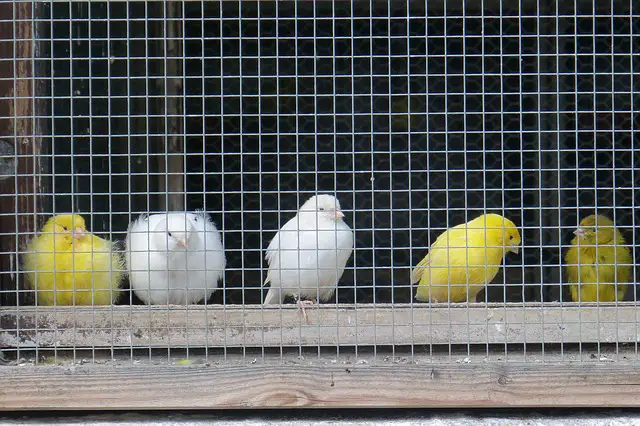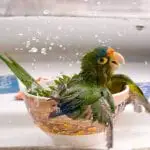If you love birds a lot, you would surely consider taking care of as many of them as you can. But letting different species interact with each other is something that can work or cannot work. Surely, decisions like this have risks involved that every owner should know about. Owners must analyze and assess his capabilities and situations very carefully and proceed to make decisions with caution. To help you finalize your decisions, here are some dos and don’ts that you can follow.
Do mix species that are similar in terms of size.
By combining birds that are very similar in size, you will be able to reduce the stress from your bird. This will also prevent larger species of birds from dominating the enclosure. The reason is simple: small birds can get intimidated by larger birds, even if they are species that are known for being very peaceful and friendly. When they are confined in a tight space, small birds will not be able to escape their larger bird companions.
Do not mix these species together:
It is definitely a questionable move to mix finches with quails, peafowls, and doves. You can also avoid mixing finches with hookbills, not only for their difference in size but also because hookbills, including budgies, can possibly bring danger to finches.
Do not place birds that are close relatives to prevent breeding hybrids.
To avoid hybridization, you should also avoid placing birds that are closely related in the near vicinity with each other. This is also because close species have similar preferences when it comes to feeding sites, roosting sites, and nesting sites. If you are actually seeking to be productive in terms of breeding birds and caring for their young, you have to make sure that will remove any non-breeding birds from the aviary during the breeding season, so that competition can be reduced.
Do provide extra sections for feeding and drinking.
In all bird communities, you should provide your pet birds with additional areas for food and drink bowls so that the aggressive, assertive, and competitive individuals will not have absolute control against the food and water sources. You should also monitor the bird’s flock every day to make sure that every single individual gets free access to food and water.
Do include various plant covers to serve as a divider.
Plant covers allow the division of interior space into separating roosting stops and perches, where different individuals, families, and pairs will be able to find much-needed space. This space can serve as a secure, private, and protected spot to roost and sleep. A plant cover also doubles as a source of a safe hiding place if, in any case, an individual feels threatened.
If disagreements occur within the enclosure, the birds can escape their aggressors by escaping their aggressors by hiding inside the foliage. When they are in the wild, rivals are driver off, but when they are in confinement, victims and threats protect themselves by hiding in the covers because it is impossible for them to fly away.
Do not overcrowd your pet birds.
Crowding your pet birds can cause multiple problems, including stressing your birds out. This can lead to them being more aggressive, or worse, falling victim into the habit of feather plucking.
Unfortunately, the exact bird distance has no specific formula. However, a good rule of thumb to follow is to give each pair of birds an area to perch without any form of disturbance, allowing each bird to withdraw safely away from their flock should they choose to. Each pair of birds should have a distance of at least one foot away from the other bird companions.
To achieve this goal, bird owners must be able to provide about 3 to 4 square feet of space in the aviary per pair of small to medium birds. As an example, an enclosure that measures about 3 feet in width by 6 feet in height can house about 4 to 6 pairs or 8 to 12 individual birds, depending on the bird’s habits, personalities, and sizes.
Do remove birds that cannot tolerate disturbances during the breeding season.
If you are a bird breeder, this is one thing that you should note. You should take birds that cannot withstand noise and disturbance, and you should take them into separate breeding quarters. Also, you should consider reducing the population in the bird enclosure during this season. This is because birds instinctively become more aggressive and assertive when they are breeding.
Do not keep more than one pair of each bird species.
Limiting birds to two individuals per species must be done unless you house a bird species that can survive and thrive even on a colony system. Also, bird owners must also consider refraining from including closely related species and birds with similar colors as this can build up to competition and rivalry inside the ecosystem.
Another good move for preserving genetic characteristics, you should remember to house bird species in a pair of 1 male and 1 female and never as unmated species.
Do monitor your birds every day.
You should check your birds daily and observe them against some signs of behavior that can reveal members of the community that are not getting along, for instance, fighting, chasing, and feather picking. You should also keep records of life spans and breeding results, as this is a part of the essential things you should keep track of.
Do introduce all your birds at once.
All your birds must enter your enclosure at one time, and you should also minimize all the changes within the population. You should also take note that introducing new birds in the enclosure can bring your bird some stress, and it can also upset the current social order. You should be careful not to introduce new birds most especially in the breeding season, as breeding birds will intensely and aggressively protect their breeding and nesting ground.
Do not combine peaceful bird species with over-aggressive bird species.
To make a healthy enclosure, you should mix birds with similar dispositions. Especially if you are a beginner, it is important to stick with generally peaceful species together. Some experts recommend Gouldian finches, blue-capped waxbills, and silverbills.
Moreover, you should combine individual birds that already feel at home with being in captivity. For instance, do not add a particularly flighty and nervous bird to mixed group birds. This is because individuals with flighty behavior will also upset and unnerve the rest of the birds inside the enclosure. Basically, just choose birds that will feel compatible and are most suited to living together in the same confined space.
Final Thoughts
Before you take on the adventure of caring for several bird individuals of different species, you should internalize everything that you have learned today. There are many ways that you could keep multiple species of birds, but there are strict guidelines that you must observe. If you are a beginner in this venture, you can set appointments with avian veterinarians and reputable bird breeders so that others questions and specific inquiries can be dealt with.


